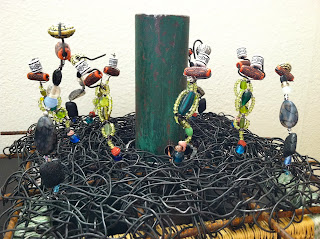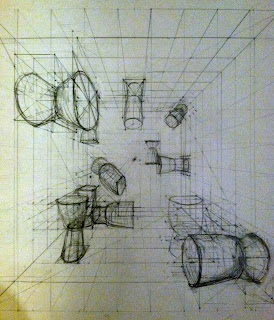Practice Welds
The project assignment was to make something heavy, or make something that looks heavy. My instructor was very adamant about not telling us to make sculpture because people can fall into the trap of just making what they think is sculpture or making sculpture that they like or have seen before.
For the following project we had to make something site specific, meaning that we have to create something to exist in a specific space, so that it cannot exist anywhere else. I came up with this contraption that slides onto this cart from the side, then you move it back, and there are metal parts that go around the wheels in order to contain them, and prevent the cart from moving.
This was my last project for metal sculpture. I wanted to do something about the Native American culture and found all sorts of stories about something called a Green Corn Ceremony. I chose to do something from the Yuchi culture because found a very useful book in the library about that culture written from an anthropological stand point. Also, that culture is more open to "outsiders" than the Iroquois. The Green Corn Ceremony takes place in August at the end of summer to celebrate the harvest. It lasts for three days. There is a ceremony to prepare the ceremonial grounds on the first day, the Green Corn Ceremony on the second day, and a soup ceremony on the last day.The Green Corn Ceremony is a story about a wise man taking teenage boys into the wilderness. He tells them not to wander off and not to go into the holes of any trees. One boy wandered off and went into the hole of a tree and there was a giant lizard that ate him. The wise man set a trap out to catch the lizard. On their way back to camp the put the head of the lizard on the top of different trees. Each tree died except for the Oak Tree. The ceremony is about this story. There are dancers that enter the square ceremonial ground and dance around in the circle counter clockwise. At a certain point there are 4 gun men that enter and circulate the dancers. At some point the dancers leave the circle and take a symbolic cleansing bath and the 4 gun men fire of blank rounds. The book I read had different interviews of different participants within the Yuchi culture, but who celebrate at a different ceremonial ground. The main point of the guns firing was to try to replicate thunder and lighting.
I made 8 dancers and 4 gunmen, using beads. Originally I actually wanted to make a totem. I kind of feel like these little figures are like totems because each bead represents something.
The gunmen have beads that represent the lighting, the lightning in the night sky, thunder, and rain. The dancers have beads to represent lizards, sea shells that are worn to make noise, and blue beads for the cleansing water. I kept repeating the numbers 4 or used multiples of 4 to keep in line with that tradition. Also, the yellow more twine like waxy string is meant to represent the east because that is where the sun rises, and the opposite side has dark string.
I used a metal square frame and this rebar grid and wrapped rebar wire. I didn't do any welding for this because I felt like the idea of permanence conflicts with the Native American tradition. I found some butcher string that I used to wrap around the frame, and I made sure to do this counter clockwise, (as I also did with the weaving of the rebar wire.) I drilled holes in two cylinders to run a metal rod through the lower set of holes for this whole piece to rest on.
























































































